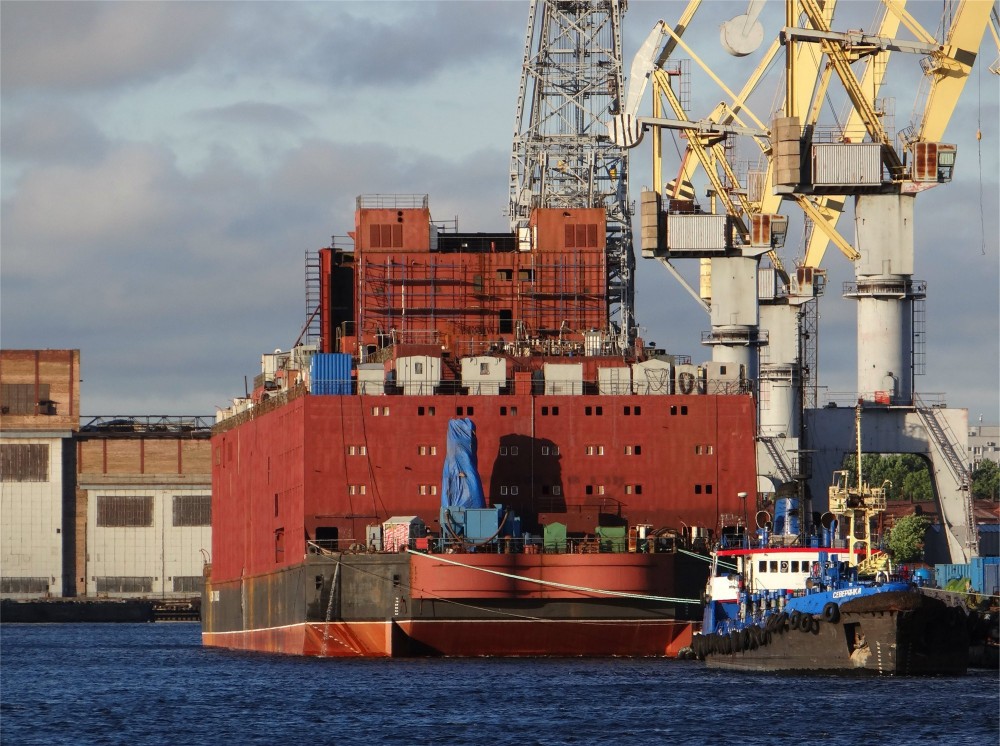Russian state nuclear corporation Rosatom now says it will fuel its first floating nuclear power plant by October 2018 after it has been towed to the Atomflot icebreaker port in Murmansk in May earlier that same year, RIA Novosti reported.
Russian state nuclear corporation Rosatom now says it will fuel its first floating nuclear power plant by October 2018 after it has been towed to the Atomflot icebreaker port in Murmansk in May earlier that same year, RIA Novosti reported.
The new fueling plan for the Akademik Lomonosov, as the plant is called, comes at the request of the Norwegian Foreign Ministry, which was not anxious to have two first-of-their-kind waterborne reactors loaded with uranium lurking off its 25,000-kilometer coast while they are en route to the Pacific Ocean.
In July, after years of pressure from Bellona and negotiations with Norwegian Foreign Minister Børge Brende, Rosatom agreed not to fuel the plant before towing it to its final port of Pevek, on the far eastern Kamchatka Peninsula.
Yet if the Akademik Lomonosov’s decade long history of protracted delays and cost overruns is any guide, it seems doubtful that Rosatom will adhere even to this latest change in the fueling schedule.
When it is finally complete, the plant will replace the energy supplied to the Chutkotka Autonomous Region by the Bilibino Nuclear Power Plant, which Rosatom plans subsequently to decommission.
It could be a long wait.
 The Akademik Lomonosov under construction at the Baltic Shipyard. (Photo: Rosatom)
The Akademik Lomonosov under construction at the Baltic Shipyard. (Photo: Rosatom)
Originally, Rosatom intended to fuel the plant at the Baltic Shipyard, where it was moved from Severodvinsk to complete its construction in 2008. The catch: the shipyard is located in the midst of a city of 5 million people, less than two kilometers from the Winter Palace, St Isaac’s Cathedral and other tourist meccas.
Environmentalists like Bellona’s Alexander Nikitin and Scandinavian diplomats have been prodding Rosatom about the fueling plans since then, but until recently, the corporation had maintained a stony silence about where and when the plant would be fueled.
Some, like Nikitin, speculated that Rosenergoatom, the Russian utility responsible for nuclear fueling operations, might have been packing the plant’s reactors on the sly. Local legislators, meanwhile, stirred up opposition to the fueling operation and demanded city hall draw up evacuation plans in the event of disaster.
A fire that broke out on the plant in July, however, seems to have loosened Rosatom’s tongue. In a series of letters with Brende, Rosatom chief Alexei Likhachev acknowledged Norway’s concerns over the fueling operations, and days later announced the change of plans.
Yet, even following the statement that the fueling would be moved to somewhere near Murmansk, it remained unclear whether Rosatom would load the Akademik Lomonosov’s reactors at Atomflot, Severodvinsk or at any of a handful of other places in the Arctic that could undertake such a challenge.
Rosatom’s latest announcement clears that up, but there’s reason to be skeptical that the fresh list of target dates will move the plant forward by much.
Throughout its history, the plant has smashed through one deadline after the next, and been dogged by lawsuits and property disputes.
Yet, fueling the vessel at Atomflot doesn’t’ mean the Akademik Lomonosov can escape fueling disasters.
An explosion during a nuclear submarine refueling operation in 1985 blew radioactive debris all over Chazhma Bay near Vladivostok, killing 10 and injuring 49. It was later discovered that the nuclear fuel had shot out of the Echo II class submarine into neighboring vessels, onto the shore and into the water.
Two thousand people were involved in the ensuing cleanup operations, 290 of who were exposed to high levels of radiation. Decades later, portions of the seabed are still severely contaminated. The Soviet government kept the accident hushed up until 1993.





